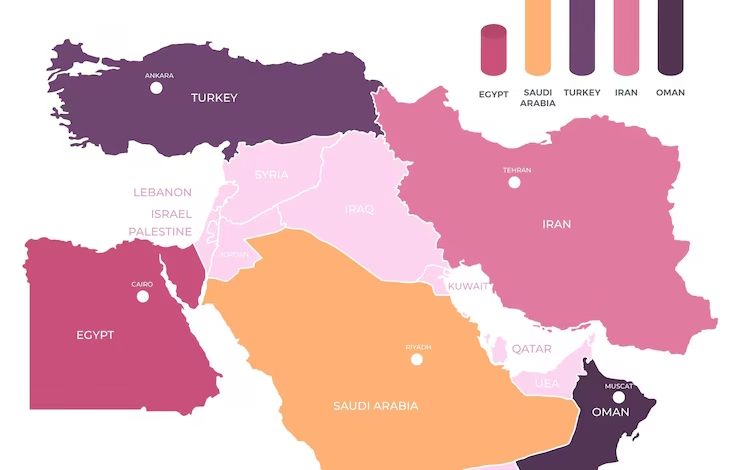Levantului: A Rich Tapestry of History, Culture, and Geography

The Levant, a region that stretches from the Eastern Mediterranean shores to parts of the Arabian Peninsula, is one of the world’s most historically significant areas. Encompassing modern-day countries such as Lebanon, Syria, Jordan, Israel, Palestine, and parts of Turkey and Iraq, the Levant has long been at the crossroads of civilizations, religions, and trade routes. Its importance transcends geography, playing a pivotal role in the development of global history, culture, and even modern geopolitics.
In this article, we will delve into the rich history, cultural influences, geographical features, and contemporary significance of the Levant. Whether you’re a history enthusiast, a traveler planning to explore the region, or just curious about its role in the world, this guide will provide you with a comprehensive overview.
What is the Levant?
The Geographic Boundaries of the Levant
The term Levant comes from the French word lever (meaning “to rise”), referring to the direction of the sunrise. Geographically, the Levant spans the eastern Mediterranean coast, including parts of the Middle East. The modern-day countries that comprise the Levant are:
-
Syria
-
Lebanon
-
Jordan
-
Israel
-
Palestine
-
Turkey (specifically the Hatay region)
-
Iraq (parts of the region, especially around the Euphrates)
It is important to note that the Levant does not refer to one single political or cultural entity. Instead, it’s a geographical and historical term that encompasses a diversity of nations, ethnicities, and traditions.
Historical Evolution of the Levant Region
The Levant’s history stretches back thousands of years. This region has been home to numerous ancient civilizations, including the Sumerians, Phoenicians, Egyptians, Israelites, and Greeks. Over centuries, the Levant was ruled by a multitude of empires, such as the Romans, Byzantines, Ottomans, and even the French and British during their respective mandates.
Each empire and civilization contributed to the Levant’s complex cultural and historical fabric. From the ruins of ancient Phoenician cities to the Jerusalem Temple, the region holds a profound historical significance.
The Ancient Levant: A Cradle of Civilizations
Early Inhabitants and Neolithic Settlements
The Neolithic period (around 10,000 BCE) marked a major turning point in Levantine history. Early human settlers in the Levant were among the first to transition from a hunter-gatherer lifestyle to settled agricultural communities. Key archaeological sites such as Jericho (in modern-day Palestine) show evidence of some of the earliest known towns, with fortified walls dating back to around 8,000 BCE.
The Rise of Ancient Kingdoms: Phoenicians, Israelites, and More
Several important civilizations emerged from the Levant during ancient times:
-
The Phoenicians: Famous for their seafaring and trade expertise, the Phoenicians established important city-states like Tyre and Sidon, leaving behind a legacy of the Phoenician alphabet, which influenced the Greek and Latin scripts.
-
The Israelites: The region is of great religious significance to Jews, Christians, and Muslims. Ancient Israel and Judah, key biblical kingdoms, were located in the Levant.
-
The Egyptians: While not geographically part of the Levant, Egypt’s interaction with the region was critical, particularly in the Exodus story and in the ancient trade routes.
-
The Greeks and Romans: Following the conquests of Alexander the Great, Greek and Roman influence permeated the Levant. Hellenistic cities like Antioch and Seleucia flourished during this period.
The Levant in the Modern Era
Colonial and Post-Colonial History
In the early 20th century, the Levant was part of the Ottoman Empire until its collapse after World War I. Following the war, European powers (especially France and Britain) divided the Levant into mandates, leading to the creation of modern nations like Syria, Lebanon, Jordan, and Israel. The borders drawn during this period have often been a source of conflict, as they do not necessarily correspond to the ethnic or sectarian lines that existed in the region for millennia.
The Impact of Modern Politics and Conflicts
In modern times, the Levant has been home to several significant geopolitical conflicts, including:
-
The Arab-Israeli Conflict: Perhaps the most widely known conflict, centered around issues of land, sovereignty, and religion, particularly regarding Palestine and Israel.
-
The Syrian Civil War: A brutal ongoing conflict that has had profound impacts on Syria, Lebanon, and even the broader Middle East.
-
Lebanon’s Civil War: Spanning from 1975 to 1990, Lebanon’s internal conflict had regional and international implications, including the involvement of various foreign powers.
Cultural Diversity in the Levant
Religion: A Melting Pot of Faiths
The Levant is the birthplace of three major monotheistic religions:
-
Judaism: Jerusalem is considered one of the holiest cities in Judaism, and the Western Wall is a significant site.
-
Christianity: The Levant is home to many of the most significant Christian pilgrimage sites, including Bethlehem, the birthplace of Jesus.
-
Islam: The region’s significance to Muslims is immense, with Jerusalem housing the Al-Aqsa Mosque, one of Islam’s holiest sites.
Other religious minorities, such as Druze, Alawites, and various Christian denominations, also contribute to the Levant’s religious mosaic.
The Levantine Languages: A Linguistic Overview
The Levant is a linguistically rich region. Arabic is the dominant language across most of the Levant, though local dialects differ significantly. Other languages, including Hebrew in Israel, Aramaic (once widely spoken but now critically endangered), and French in Lebanon, reflect the historical influences of colonial powers.
The Arts, Cuisine, and Traditions
The Levantine culture is famous for its arts, music, and cuisine. The region is known for its distinctive Arabic music, its literature (including poetry from figures like Khalil Gibran), and its culinary staples, such as hummus, falafel, and tabbouleh.
Geography and Climate
Landscapes: From Deserts to Fertile Plains
The Levant features a diverse range of landscapes, from the fertile plains of Lebanon and Syria to the deserts of Jordan and Israel. The region’s geography influences its agricultural practices, including the cultivation of olive trees, grapes, and citrus fruits.
Weather Patterns and Natural Resources
The climate varies significantly across the Levant. Coastal areas tend to have a Mediterranean climate with hot, dry summers and mild, wet winters, while the interior can be arid and semi-arid. The region has significant natural resources, including phosphate in Jordan, oil reserves in Syria, and freshwater sources like the Jordan River.
Levant Today: The Region’s Geopolitical Significance
The Levant continues to play a crucial role in global geopolitics. It is a strategic location for trade routes, particularly those connecting Europe, Asia, and Africa. Additionally, the region’s rich natural resources, including gas reserves off the coast of Israel and Lebanon, are of great interest to global powers.
Contemporary Issues in the Levant
The Levant is not without its challenges. From ongoing conflicts to economic hardship, the region faces numerous political, social, and environmental hurdles. Issues such as refugee crises, water scarcity, and political instability remain pressing concerns.
Conclusion
The Levant remains one of the most significant and fascinating regions in the world. From its ancient roots to its modern-day geopolitical importance, the Levant continues to shape global culture, religion, and politics. Whether you’re a traveler, historian, or someone interested in understanding the dynamics of the Middle East, the Levant offers a wealth of knowledge and insight.
FAQ: Common Questions About the Levant
What countries make up the Levant?
The Levant includes parts of modern-day Syria, Lebanon, Jordan, Israel, Palestine, Turkey (Hatay province), and parts of Iraq.
Why is the Levant historically important?
The Levant has been a crossroads for ancient civilizations, hosting the birthplaces of major religions and serving as a vital part of ancient trade routes.
What is the cultural significance of the Levant?
The Levant is a cultural melting pot, known for its rich traditions in art, music, religion, and cuisine. The region is home to multiple religious and ethnic groups that have shaped its history for millennia.



